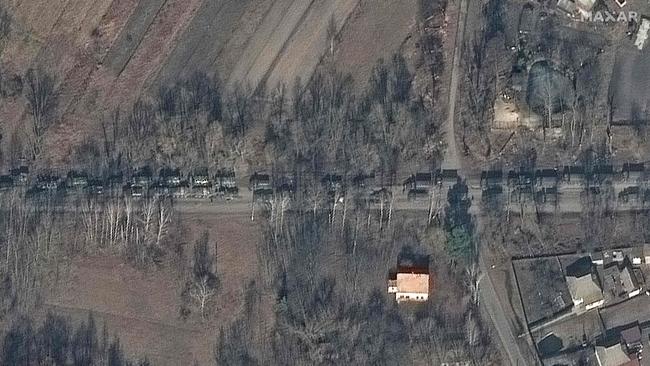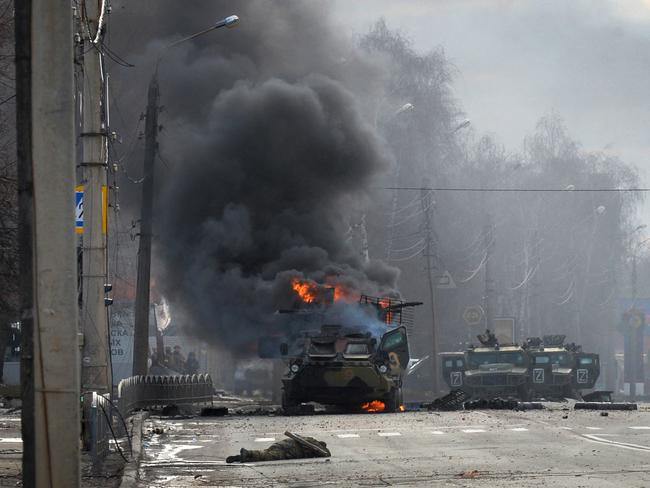Resistance shatters Putin plan for victory in 24 hours
Vladimir Putin had believed he could take cities including Kyiv within 48 hours, defence sources say, but Russia has failed to control the air.

Russian President Vladimir Putin believed he could capture Kyiv and as many as four other cities within 48 hours of launching his invasion, according to British and Ukrainian defence sources.
The plan was for Ukraine President Volodymyr Zelensky to surrender and sign over his country to Russia at the historic Pechersk Lavra monastery, which Mr Putin visited in 2004, a military source claimed.

However, his war has not gone to plan, with Russian troops coming up against fierce Ukrainian resistance and analysts pointing to failures in basic military tactics and a lack of morale.
Ukrainian diplomat Dmytro Tretiakov, first secretary at the embassy in London, said Russia’s advance had been slower than expected because “this is our soil, our families, our homes”. He said the Ukrainian people and military, backed by allies, had “no fear” and were not panicking.
Ukrainian forces have brought down Russian Su-30 warplanes and military transport aircraft, blown up dozens of tanks and hundreds of armoured vehicles, and brought down cruise missiles.

They have surpassed expectations, mystifying observers and even Western military experts by preventing Russia from gaining control of the skies, denying Mr Putin his initial strategic objectives.
Although Ukraine’s army is tiny compared with Russia’s – with 196,600 troops against 900,000 – it is a military truism that it requires three or four attacking units to defeat one defending unit. “If you want to attack a platoon, you need a company,” a British Army source said.
Kevin Price, a former major who served 20 years in the British military, said Mr Putin was throwing “very green” soldiers up against Ukrainian forces that had massively improved since the annexation of Crimea in 2014.
“Is Putin just throwing in a whole bunch of youngsters to the fight to get the sense of what Ukrainian forces are like, and holding back the more battle-ready troops?” he questioned, adding that the Russian tactics did not make sense.
Since 2015 about 22,000 Ukrainian troops have been trained by the British Army as part of Operation Orbital.
Mr Price said anti-armour ambushes of the sort deployed by Ukrainian forces were pretty much the bread and butter of the British infantry, adding: “If you have a classic column of 10 to 20 tanks and you’ve got a wide field of fire, then you can knock two or three of them out and then the rest are sitting ducks and they can’t reverse out. Then you finish them off,” he said.

The army source said tanks appeared to be driving into villages unsupported – without armoured vehicles and foot soldiers – making it easier for Ukrainian forces to attack them. The fact the Russians had drawn white battle-group markings, including the letters “Z” and “V” on armour, made them easier to identify.
Then there is the morale of the Russians, with UK Defence Secretary Ben Wallace saying last week that some had either been captured or had deserted their positions once they found out the operation was not what they had signed up for.
Ukrainian military sources said that on the way to Chernigov in the north, several units gave up their vehicles and retreated because they had run out of fuel. The source said that Russian troops were also begging residents for food in some places.
According to a reporter with The Kyiv Independent, two Russian soldiers in Kharkiv also turned up at a Ukrainian police station asking for fuel.
Another army source pointed to an Ilyushin IL-76 heavy transport aircraft being shot down, noting it was unwise for Russia to fly in such aircraft when it did not have control of the skies.

“No one in their right mind sends that in before they are sure that won’t happen. When they carry out these tactics and keep failing, it erodes morale. People know that they could die in an air transport aircraft or from a Molotov cocktail in the street,” they added.
Mr Price said footage on social media had suggested the Ukrainians had also moved their ageing fighter jets to random locations across the country so that many of them had not been blown up by the initial Russian operation to destroy airfields.

Justin Crump, of Sibylline, an intelligence and geopolitical risk firm and a military veteran, said the resistance was stiffer than expected, with Ukrainians fighting “tooth and nail” in places and denying the Russians the use of bridges and railways.
There have been problems with supply chains, with Russian forces trying to camouflage their fuel tankers as lorries because they were being picked out as a “critical weakness”, he said.
However, he noted that Russia’s high-quality and professional lead armoured elements had actually advanced a long way, 70km on the first day alone.
He also pointed out they had not deployed artillery en masse yet – which was their greatest combat advantage.
Estimates suggest that only 60 per cent of Mr Putin’s 190,000-strong military machine surrounding Ukraine has been deployed.
The Times



To join the conversation, please log in. Don't have an account? Register
Join the conversation, you are commenting as Logout